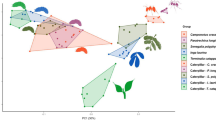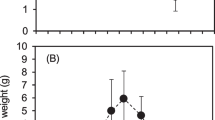Abstract
One effect of global warming may be an increase in night-time temperatures with daytime temperatures remaining largely unchanged. We examined this potential effect of global warming on the performance of tobacco hornworm larvae, Manduca sexta (Sphingidae), by manipulating night-time temperature and dietary rutin levels simultaneously under a 12 light:12 dark photoregime. All four thermal regimes (26:14, 26:18, 26:22, and 26:26° C) had a daytime temperature of 26° C, with the night-time temperature increased from 14 to 26° C by increments of 4° C. Dietary rutin levels (0, 10 and 20 μmoles g−1 fresh weight of diet) reflected those occurring naturally in the leaves of tomato, a preferred host plant of M. sexta. With low night-time temperatures (14 and 18° C), rutin had a negative linear effect on developmental rate, relative growth rate and relative consumption rate of the caterpillars. However, at a night-time temperature of 22° C, rutin had a negative non-linear effect. At a night-time temperature of 26° C, rutin had a negative linear impact but less so than at the other nightime temperatures. Likewise, the negative effect of rutin on molting duration was mitigated as night-time temperature increased. Final larval weight decreased linearly with increased dietary rutin concentrations. Total amount of food ingested was not affected by either rutin or thermal regime. As expected, the caterpillars developed faster under an alternating 26:14° C regime than a constant 20° C regime (the average temperature for the alternating regime), but the effect of rutin depended on the thermal regime. Switching daytime and night-time temperatures had no statistically significant effect on caterpillar performance. Overall, the effect of rutin on rates of larval performance was greater at some levels of warmer nights but damped at another level. These results indicate that the potential effect of warmer nights on insect performance is not a simple function of temperature because there can be interactions between night-time temperature and dietary allelochemicals.
Similar content being viewed by others
References
Allen GR (1990) Influence of host behavior and host size on the success of oviposition of Cotesia urabae and Dolichogenidea eucalypti (Hymenoptera: Braconidae). J Insect Behav 3:733–749
Beck SD (1983) Insect thermoperiodism. Annu Rev Entomol 28:91–108
Beck SD (1991) Thermoperiodism. In: Lee RE Jr, Denlinger DL (eds) Insects at low temperature. Chapman and Hall, New York, pp 199–228
Bernays EA, Chapman RF (1977) Deterrent chemicals as a basis of oligophagy in Locusta migratoria. Ecol Entomol 2:1–18
Bloem KA, Kelley KC, Duffey SS (1989) Differential effect of tomatine and its alleviation by cholesterol on larval growth and efficiency of food utilization in Heliothis zea and Spodoptera exigua. J Chem Ecol 15:387–398
Broadway RM, Duffey SS (1988) The effects of plant protein quality on insect digestive physiology and the toxicity of plant proteinase inhibitors. J Insect Physiol 34:1111–1117
Bursell E (1973) Environmental aspects — temperature. In: Rockstein M (ed) The physiology of Insecta. Academic Press, New York London, pp 1–41
Casey TM (1977) Physiological response to temperature of caterpillars of a desert population of Manduca sexta (Lepidoptera: Sphingidae). Comp Biochem Physiol 57A:53–58
Duffey SS, Isman MB (1981) Inhibition of insect larval growth by phenolics in glandular trichomes of tomato leaves. Entomol Exp Appl 37:574–576
Duffey SS, Bloem KA, Campbell BC (1986) Consequences of sequestration of plant natural products in plant-insect-parasitoid interactions. In: Boethel DJ, Eikenbary RD (eds) Interactions of plant resistance and parasitoids and predators of insects. Wiley, New York, pp 31–60
Eizaguirre M, Lopez C, Albajes R (1994) Thermoperiodism, photoperiodism and sensitive stage in the diapause induction of Sesamia nonogrioides (Lepidoptera: Noctuidae). J Insect Physiol 40:113–119
Felton GW, Summers CB (1993) Potential role of ascorbate oxidase as a plant defense protein against insect herbivory. J Chem Ecol 19:1553–1568
Harborne JB (1979) Variation in and functional significance of phenolic conjugation in plants. Recent Adv Phytochem 12:457–474
Heuvelink E (1989) Influence of day and night temperature on the growth of young tomato plants. Sci Hort 38:11–22
Horwath KL, Stamp NE (1993) Use of dietary rutin to study molt initiation in Manduca sexta larvae. J Insect Physiol 39:987–1000
IPCC (Intergovernmental Panel on Climate Change) (1990) Scientific assessment of climate change. World Meteorological Organization/United Nations Environmental Programme Geneva, Switzerland. Cambridge University Press, Cambridge, UK
Jones CG, Firn RD (1979) Some allelochemicals of Pteridium aquilinum and their involvement in resistance of Pieris brassicae. Biochem Syst Ecol 7:187–192
Karl TR, Kukla G, Razuvayev VN, Changery MJ, Quayle RG, Heim RR Jr, Easterling DR, Fu CB (1991) Global warming: evidence for asymmetric diurnal termperture change. Geophys Res Lett 18:2253–2256
Karl TR, Jones PD, Knight RW, Kukla G, Plummer N, Razuvayev V, Gallo KR, Lindseay J, Charlson RJ, Peterson TC (1993) Asymmetric trends of daily maximum and minimum temperature. Bull Am Meteorol Soc 74:1007–1023
Mead R (1988) The design of experiments: statistical principles of practical application. Cambridge University Press, Cambridge, UK
Morris RF (1963) The effect of predator age and prey defense on the functional response of Podisus maculiventris Say to the density of Hyphantria cunea Drury. Can Entomol 95:1009–1020
National Climate Center (1979) Comparative climatic data for the United States through 1978. National Oceanic and Atmospheric Administration. Asheville, NC
Ochieng'-Odero JPR (1994) The effect of photoperiod and thermoperiod on the larval critical weight, latent feeding period, larval maximal weight and fecundity of Cnephasis jactatana (Walker) (Lepidoptera: Tortricidae). J Insect Physiol 37:441–445
Ratte HT (1984) Temperature and insect development. In: Hoffmann KH (ed) Environmental physiology and biochemistry of insects. Springer, Berlin Heidelberg New York, pp 33–66
Raubenheimer D, Simpson SJ (1992) Analysis of covariance: an alternative to nutritional indices. Entomol Exp Appl 62:221–231
Reynolds SE, Nottingham SF (1985) Effects of temperature on growth and efficiency of food utilization in fifth-instar caterpillars of the tobacco hornworm, Manduca sexta. J Insect Physiol 31:129–134
Reynolds SE, Yeomans MR, Timmins WA (1986) The feeding behavior of caterpillars (Manduca sexta) on tobacco and artificial diet. Physiol Entomol 11:39–51
Salt G (1938) Experimental studies in insect parasitism. VI. Host suitability. Bull Entomol Res 29:223–246
SAS Institute Inc (1989) SAS/STAT User's Guide, version 6. SAS Institute Inc, Cary, NC
Schneider SH (1992) The climatic response to greenhouse gases. In: Woodward FI (ed) The ecological consequences of global climate changes. Academic Press, New York London, pp 1–32
Schneider SH (1993) Scenarios of global warming. Sinauer Associates Inc, Sunderland, Mass
Schramm U (1972) Temperature-food interaction in herbivorous insects. Oecologia 9:399–402
Scriber JM, Slansky F Jr (1981) The nutritional ecology of immature insects. Annu Rev Entomol 26:183–211
Slansky F Jr (1992) Allelochemical-nutrient interaction in herbivore nutritional ecology. In: Rosenthal GA, Berenbaum MR (eds) Herbivores: their interaction with secondary plant metabolites. Academic Press, New York London, pp 135–174
Slansky F Jr, Scriber JM (1985) Food consumption and utilization. In: Kerkut GA, Gilbert LI (eds) Comparative insect physiology, biochemistry and pharmachology, Pergamon Press, Oxford, pp 87–163
Stamp NE (1990) Growth versus molting time of caterpillars as a function of temperture, nutrient concentration and phenolic rutin. Oecologia 82:107–113
Stamp NE (1994) Interactive effects of rutin and constant versus alternating temperatures on performance of Manduca sexta caterpillars. Entomol Exp Appl 72:125–133
Stamp NE, Bowers MD (1990) Variation in food quality and temperature constrain foraging of gregarious caterpillars. Ecology 71:1031–1039
Stamp NE, Horwath KL (1992) Interactive effects of temperature and concentration of flavonol rutin on growth, molt and food utilization of Manduca sexta caterpillars. Entomol Exp Appl 64:135–150
Stamp NE, Temple MP, Traugott MS, Wilkens RT (1994) Temperture-allelochemical interactive effects on performance of Manduca sexta caterpillars. Entomol Exp Appl 73:199–210
Steel RGD, Torrie JH (1980) Principles and procedures of statistics: a biometrical approach. McGraw-Hill, New York
Thomas WM (1991) Modeling the effect of temperature and gossypol concentration on developmental rate of Helicoverpa zea (Boddie) (Lepidoptera: Noctuidae). J Econ Entomol 84:466–469
Volker KC, Simpson RG (1975) Behavior of alfalfa weevil larvae affecting the establishment of Tetrastichus incertus in Colorado. Environ Entomol 4:742–744
Waldbauer GP (1968) The consumption and utilization of food by insects. Adv Insect Physiol 5:229–288
Went FW (1944) Plant growth under controlled condition. II. Thermoperiodicity in growth and fruiting of the tomato. Am J Bot 31:135–150
Went FW (1945) Plant growth under controlled condition. V. The relation between age, light, variety and thermoperiodicity. Am J Bot 32:469–479
Worner SP (1992) Performance of phenological models under variable temperature regimes: consequences of the Kaufmann or rate summation effect. Environ Entomol 21:689–699
Yamamoto RT, Fraenkel GS (1960) The specificity of the tobacco hornworm, Protoparce sexta, to solanaceous plants. Ann Entomol Soc Am 53:503–507
Yang Y, Joern A (1994) Influence of diet quality, developmental stage and temperature on food residence time in the grasshopper Melanoplus differentialis. Physiol Zool 67:598–616
Author information
Authors and Affiliations
Rights and permissions
About this article
Cite this article
Yang, Y., Stamp, N.E. Simultaneous effects of night-time temperature and an allelochemical on performance of an insect herbivore. Oecologia 104, 225–233 (1995). https://doi.org/10.1007/BF00328587
Received:
Accepted:
Issue Date:
DOI: https://doi.org/10.1007/BF00328587




